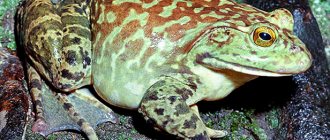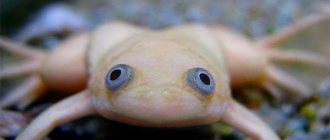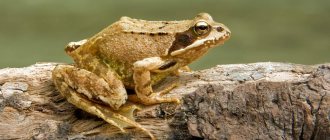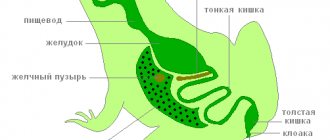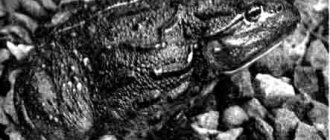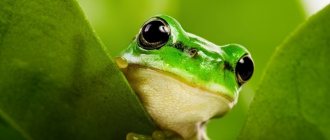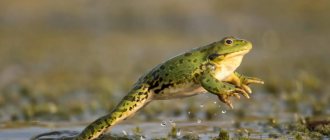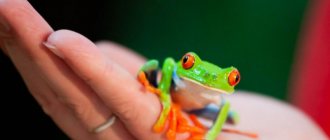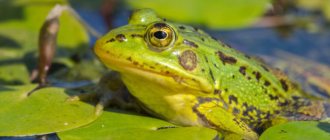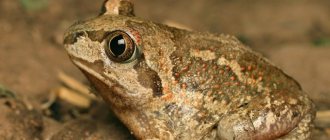There are a huge number of amphibians and other species of tailless animals in the world that can live both in water and on land. Its distinctive feature from its relatives is its purple or more violet-like color. Translated into Latin, the purple frog is called nasika, which literally means nose. This name was given to her due to the fact that on her muzzle there is a nose, white in color, but its size is so small that it just resembles a dot, of course, unless you look closely or examine it under a microscope.
Appearance of a purple frog
Already by its name, you can guess that the color of the frog is violet or, as it is also called, purple. But in this case, color is not even the main thing. Its appearance is a body of an unusual round shape. The head is very small compared to the body, and the pointed muzzle is painted white. The round eyes are also small in size with horizontal pupils and see practically nothing. But her sense of smell is enviable.
Purple frog (lat. Nasikabatrachus sahyadrensis)
The hind feet are partially webbed, and the front feet are much shorter and have rounded toes. If at first glance individuals of this species seem clumsy and clumsy, then this opinion is wrong.
The fact is that a purple frog can dig a hole for itself in literally 3 to 5 minutes, and the depth can reach 3.7 meters. Impressive, right?
Individuals of this species can grow up to 9 cm, and if the entire surface of an already adult frog is painted purple, then in the abdomen the skin color has a grayish tint.
Darwin's frog
Darwin's frog
This baby frog, which lives in the humid jungles of Latin America, weighs only 2 g and is 2 cm tall.
Darwin's frog, camouflaging itself in the foliage, can change its color “seasonally” - from bright green to brown.
Interesting fact. The female frog only lays eggs and is no longer interested in them. And the male sits next to the clutch and waits for the tadpoles to hatch. After this, he licks them with his tongue and places them in his throat sac, where they live until they are fully formed, feeding on the “daddy’s” body.
Where can you find the purple frog?
After reading the information about this amphibian, a direct question arises. Why were these frogs, which have existed on earth for so many years, discovered relatively recently? And the answer to this question is very simple. The fact is that the purple frog is widespread in small Indian territories - the Western Ghats, the total area of which is only about 14 square meters. km. The first specimens of frogs were discovered in the Kattapan region and near the town of Idukki.
The purple frog rarely comes to the surface from its burrow.
Naturally, local residents had already come across these frogs, whose body resembled a jelly mass, but zoologists were not particularly interested in this information. The story of the discovery of purple frogs began after Professor Biju saw one of them.
Hairy frog
Hairy frog
The hairy frog is common in some African countries.
In fact, this is not hair, but strips of skin formed by males during the breeding season.
Amazing fact. Hairy frogs are born without claws, but if they want, they can make them for themselves. To do this, they break the bones of their fingers and pierce the skin with them. This becomes an excellent defense when attacked by the enemy.
But not protection from humans. Cameroonians consider hairy frogs a delicacy and love them fried.
Lifestyle
Almost an amphibian of this species spends its entire life underground, sometimes coming to the surface only to prolong the genus. Since she constantly needs a moist environment, she digs a deep hole for herself, using her paws as shovels, throwing the earth behind her back.
A purple frog is busy with excavation work.
After “work”, taking a horizontal position and tucking its paws under itself, the frog rests.
Mossy frog
Mossy frog
Another name for this “beauty” is the lichen copepod. Where do these names come from? Because of the peculiar mottled, lumpy skin that looks like moss or lichen.
These amphibians can only be seen on the shores of reservoirs in Northern Vietnam, and their “homes” are underwater caves or half-rotten hollows of coastal trees.
A distinctive feature of the moss frog is the round suckers at the ends of its toes, which allow it to climb trees well.
Interesting fact. When an enemy approaches, the lichen copepod curls up into a ball and pretends to be dead.
Purple frog breeding
When the rainy season arrives, the frog comes to the surface. Having decided on a partner, they begin mating. During the process, the male, using the sticky properties of his skin, sticks to the female from behind. This is explained by the fact that the male individual of these frogs is somewhat smaller in size than the female, and can simply slide down.
These frogs can be classified as irresponsible parents.
Using its narrow muzzle, the frog takes insects out of their hiding places.
After the eggs are laid in the water, the adults go underground again. And the hatched tadpoles are forced to fend for themselves.
Reproduction. Love songs
Amphibians come out during the tropical rains and gather near small bodies of water to mate. It is noteworthy that in order to attract females, males burrow into a small hole filled with mud and water and begin to sing songs. The sound they make is short, repeating trills. Peculiar ballads about love, to which females respond.
Since males are slightly smaller than their lovers, they adhere to the female's body using a sticky secretion on the surface of the skin. The act of love itself occurs in the form of an “groin grab” - the male clasps the female’s hind legs. After the reproduction process is completed, the fertilized eggs are placed in a pond. They will hatch into the same small and strange creatures that will live underground and surprise us with their appearance.
Nutrition
As already mentioned, in the search for food, the frog is helped by its excellent sense of smell. Its prey includes small worms, ants and termites. The size of her mouth does not allow her to hunt larger insects, since she simply cannot swallow them.
The purple frog swells when threatened.
With its narrow muzzle, it easily reaches into insect holes and, with the help of its grooved tongue, pulls them out.
Habitat
The purple frog spends almost its entire life underground. The ideal habitat for them is moist and loose soil in the tropical forests of Hindustan. Amphibians dig burrows 1.5-3 meters in size using strong front paws and hunt small insects.
The main dish for them is termites, to whose homes the frogs dig holes. Thanks to their narrow muzzle and grooved tongue, they can easily stick their heads into narrow passages and suck up prey. They also feed on ants and worms, but they cannot eat larger prey due to their small mouth opening.
This lifestyle provided the creation with an excellent sense of smell and special sensory cells for finding prey. They have poor eyesight, which is due to their long stay underground. After all, they come out of their underground castles for several weeks a year with one goal - to find a mate and have offspring.
Links[edit]
- S. D. Bijou (2004). " Nasikabatrachus sahyadrensis
".
IUCN Red List of Threatened Species
.
2004
: e.T58051A11722468. DOI: 10.2305/IUCN.UK.2004.RLTS.T58051A11722468.en. - Biju, SD; Bossuyt, F. (2003). "New family of frogs from India reveals ancient biogeographical connection to Seychelles." Nature
.
425
(6959):711–714. Bibcode: 2003Natur.425..711B. DOI: 10.1038/nature02019. PMID 14562102. S2CID 4425593. - ^ab Annandale, N. and Rao, C.R.N. (1917). "Indian tadpoles." Proceedings of the Asiatic Society of Bengal
.
13
: 185–186. - Das, Indraneil (2007). "Some forgotten descriptions of Nasikabatrachus
(Anura - Sooglossidae)".
Herpetological Review
.
38
: 291–292. - Senevirathne G, Thomas A, Kerney R, Hanken J, Biju SD, Meegaskumbura M. From clinging to burrowing: postembryonic skeletal ontogeny of the Indian purple frog, Nasikabatrachus sahyadrensis
(anura: Nasikabatrachidae). PLOS ONE. 2016; 11 (3): e0151114. - ^ a b c d Zechariah, A; RK Abraham; S Das; K C Jayan and R Altig (2012). "A detailed account of the reproductive strategy and developmental stages of Nasikabatrachus sahyadrensis (Anura: Nasikabatrachidae), the only extant member of an archaic frog lineage" (PDF). Zootaxa
.
3510
: 53–64. DOI: 10.11646/zotaxa.3510.1.3. - Jump up
↑ Annandale, N. (1918).
"The Indescribable Tadpoles of the Hills of Southern India." Records of the Indian Museum
.
15
: 17–23. - Jump up
↑ Annandale, N. & Hora, S. L. (1922).
"Parallel evolution of fish and tadpoles of mountain streams". Records of the Indian Museum
.
24
: 505–510. - PLOS ONE, 2016, volume 11, issue 3
- ↑
Das, KS Anoop 2006 Record
of Nasikabatrachus
from the Northern Western Ghats. Print Journal of Zoos 21(9): 2410 PDF. Archived March 3, 2016, at the Wayback Machine. - Radhakrishnan, S.; K.S. Gopi and K.P. Dinesh (2007). "Zoogeography of Nasikabatrachus sahyadrensis
Biju and Bossuyt (Amphibian: Anura; Nasikabatrachidae) in the Western Ghats, India".
Records of the Zoological Survey of India
.
107
: 115–121. - Marshall, submitted by Michael (October 17, 2014). “Eight ugly animals we still have to save.” BBC Earth
. Retrieved January 3, 2015. The purple frog in India spends almost the entire year underground, emerging for about two weeks during the monsoon season to breed in temporary ponds created by heavy rain. - Radhakrishnan, S.; Gopi, K.C.; Jafer Palo, Mohamed (2007). "Range expansion of Nasikabatrachus sahyadrensis Biju & Bossuyt (Amphibian: Anura: Nasikabatrachidae) along the Western Ghats, with some insights into its bionomics" (PDF). Modern Science
.
92
(2):213–216. - Thomas, A.; Biju, S. D. (2015). "Tadpole consumption poses a direct threat to the endangered purple frog Nasikabatrachus sahyadrensis". Salamander
.
51
: 252–258. Archived from the original on September 25, 2015. - SD, Biju and Ashish. (2015). Eating tadpoles poses a direct threat to the endangered purple frog Nasikabatrachus sahyadrensis. Salamander. 51.252-258.
LiveInternetLiveInternet
Now we will talk about another unusual amphibian - the purple frog. It actually has a purple (violet) color. But what attracts most attention to it is that this frog spends almost its entire life underground. The frog only comes to the surface for a couple of weeks, during the breeding season.
Purple frog or lilac frog (lat. Nasikabatrachus sahyadrensis) (eng. Purple frog)
The purple frog is the only species of purple frog belonging to the Seychelles frog family. The official discovery and classification of this species occurred only in 2003. It lives in small areas in the Western Ghats (Ghats) in India with a total area of about 14 square meters. km. This species was found near the small town of Idukki and in the Kattapan region.
Its Latin name comes from the word “nasika”, which means “nose” in Sanskrit.
The purple frog's body has a slightly unusual shape. It is more round than other frog species. What catches your eye is its small head compared to its body and the pointed shape of its white muzzle. Adults are purple in color, but in the abdominal area its smooth skin takes on a grayish tint. These frogs grow up to 7-9 centimeters.
These amphibians lead a completely underground lifestyle. For a comfortable existence, they need a humid environment. Therefore, they dig deep holes for themselves, which can go into the ground to a depth of 1.3-3.7 meters.
The underground lifestyle and the specific structure of the head (narrow head with a small mouth) influenced the diet of this frog. Its main food is termites. It simply cannot swallow larger insects. The frog easily pushes its narrow muzzle into various underground niches and passages, and its grooved tongue helps it suck its prey from these holes.
In the underground world, a frog does not need good eyesight, but an excellent sense of touch helps to detect and locate prey. In addition to termites, she can snack on ants and small worms.
These amphibians come to the surface only during the monsoon period to reproduce. Perhaps that is why it remained an unknown species to the scientific world for a long time. Although local residents had already known about it for a long time, until 2003 scientists treated their words with a grain of skepticism, until they themselves were convinced of its existence.
The frog comes to the surface for only a couple of weeks. Mating occurs near temporary or permanent bodies of water, on the banks of small rivers or ditches. Males attach to females using what is called an “groin latch.” Since they are slightly smaller than their chosen ones, in order to hold on, the males partially glue themselves to the female, using a sticky secretion from the skin. The eggs are laid in the water. After some time, tadpoles emerge from them.
The ancestors of these frogs are representatives of a very ancient species that existed about 180 million years ago and was distributed on the continental massif, which was part of the ancient southern supercontinent Gondwana. This supercontinent then split into Australia, Africa, India, Madagascar and most of Antarctica. And about 65 million years ago, the Seychelles islands broke away from India, where their close relatives belonging to the family Sooglossidae now live.
The Seychelles palm frog is one of the close relatives of the purple frog
Due to deforestation, the purple frog is in danger of becoming extinct. It is included in the IUCN Red Book.
High-quality text optimization from professionals in the shortest possible time!
Any log houses at attractive prices!
Tree frog Pumilio
Darter frog Pumilio
Another name for it is “dart frog”. This small (2 cm in length) and very brightly colored frog lives in the forests of Africa and Central America. It's like she's telling everyone not to touch her! The Pumilio poison dart frog is one of the most poisonous creatures in the world. Their skin secretes a poison that, when ingested by a person or animal, causes cardiac arrest. The poison of one dart frog is enough to kill 10 people!
Interesting Facts.
The body of these frogs does not produce poison; it enters it with food - ants and ticks.
Aborigines of countries where dart frogs are found moisten the tips of military and hunting arrows with their poison. How do they collect the poison? Avoiding open contact with the frog's skin, place it over the fire. From the heat, the amphibian soon begins to secrete poison from its skin, which is immediately applied to the arrows.
